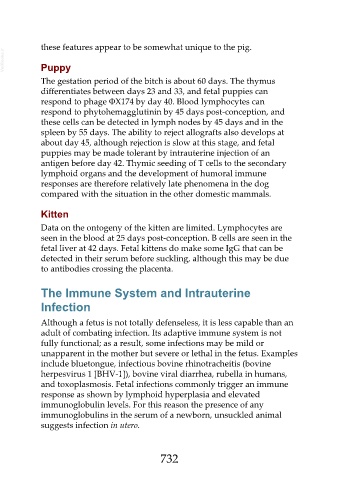Page 732 - Veterinary Immunology, 10th Edition
P. 732
these features appear to be somewhat unique to the pig.
VetBooks.ir Puppy
The gestation period of the bitch is about 60 days. The thymus
differentiates between days 23 and 33, and fetal puppies can
respond to phage ΦX174 by day 40. Blood lymphocytes can
respond to phytohemagglutinin by 45 days post-conception, and
these cells can be detected in lymph nodes by 45 days and in the
spleen by 55 days. The ability to reject allografts also develops at
about day 45, although rejection is slow at this stage, and fetal
puppies may be made tolerant by intrauterine injection of an
antigen before day 42. Thymic seeding of T cells to the secondary
lymphoid organs and the development of humoral immune
responses are therefore relatively late phenomena in the dog
compared with the situation in the other domestic mammals.
Kitten
Data on the ontogeny of the kitten are limited. Lymphocytes are
seen in the blood at 25 days post-conception. B cells are seen in the
fetal liver at 42 days. Fetal kittens do make some IgG that can be
detected in their serum before suckling, although this may be due
to antibodies crossing the placenta.
The Immune System and Intrauterine
Infection
Although a fetus is not totally defenseless, it is less capable than an
adult of combating infection. Its adaptive immune system is not
fully functional; as a result, some infections may be mild or
unapparent in the mother but severe or lethal in the fetus. Examples
include bluetongue, infectious bovine rhinotracheitis (bovine
herpesvirus 1 [BHV-1]), bovine viral diarrhea, rubella in humans,
and toxoplasmosis. Fetal infections commonly trigger an immune
response as shown by lymphoid hyperplasia and elevated
immunoglobulin levels. For this reason the presence of any
immunoglobulins in the serum of a newborn, unsuckled animal
suggests infection in utero.
732

